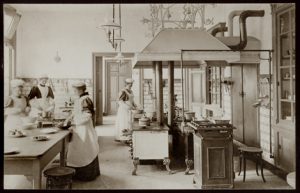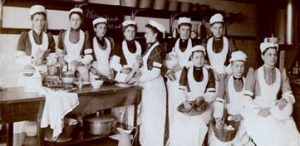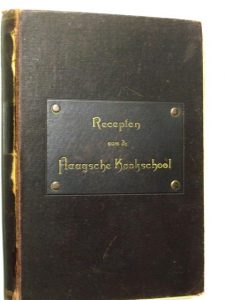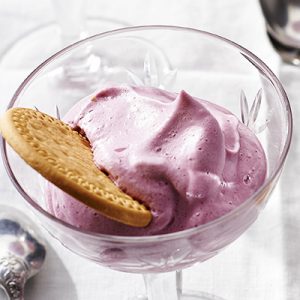Nowadays, my search for recipes usually begins and ends on the internet. Not so in 1973! That year Saint Nicholas gave me my first cookbook, titled “Het Haagse Kookboek”. It was the 64th edition, and came with a very practical plastic cover, so stains could be wiped easily.
Haagsche Cooking School

The first formal cooking education in The Netherlands was provided by the Haagsche Cooking School. Founded in 1888 by a group of women in the Hague, the school was designed to provide culinary instruction to girls and women of all of classes. It’s fair to say, however, that at that time there were distinctions. A woman with domestic staff needed to know how to instruct her cook or maid, rather than preparing meals herself. The school’s first annual report contained the comment that bad cooking by the maid opens the door to the pub for the lord of the house and leaves her mistress in loneliness, paying for her ignorance.

The school, located on Stille Veerkade 20, opened on February 20 1888 and was an instant success, with no fewer than 114 applicants for the initial course of study. During the daytime housewives and young ladies learned to cook and were given instruction in dietetics and food hygiene. In the evening – after working hours – the cooks and maids would come. Wednesday afternoons were reserved for working class girls. The food everybody prepared had to be wholesome, healthy and not too expensive.
The school also received royal attention. When Queen-Regent Emma came to visit, she was served a ‘potage à la reine’.
Recipes – The Haagsche Cookbook

In the school’s first years, students had to write down all the recipes featured in the classes. This was time-consuming and caused writer’s cramp. So the students asked Anna van Manden, the principal, to gather all her recipes in a book. This became the Haagsche Cookbook, first edition in 1895. The book contained simple meals, no luxury recipes. And its readers got information about healthy ingredients and learned about kitchen hygiene. We must remind ourselves that in 1895 it was not long since Louis Pasteur had proved that food could be contaminated by micro-organisms in the air. So there was a message to be spread!
Shortly after the publication of this book, Van Manden left the Cooking School. Her successor had a difference of opinion with the institution’s board of directors and she also left, starting her own school, the School of Domestic Science Laan van Meerdervoort.
The Haagse Cookbook

The teachers of the School of Domestic Science Laan van Meerdervoort took over the writing of the Haagse Cookbook. In 1934 teachers Frederique M. Stoll and Wilhelmina H. De Groot wrote a new version ‘hoping that many a housewife will find in this what she is looking for’.
With each edition, this new Haagse Cookbook adapted to the times. The 12th edition, published during the Second World War, included an addendum with tips and recipes to enable the readers to cope with rationing. The 1953 edition saw the appearance of the ‘five-part table of essential nutrients’, that became known in The Netherlands as the ‘schijf van vijf’ – the disc of five basic food groups.

Modern technology also found its way into the book: in 1961 our mothers could read instructions for ‘deep freezing’ food. And the Haagse Cookbook expanded your culinary view beyond the Dutch border by giving more attention to foreign and ‘exotic’ food.
The 1982 edition was renamed the New Haagse Cookbook (Het Nieuwe Haagse Kookboek). The 2010 edition is still on the market, now also as ebook.
Haagse bluf

The quintessential dish from The Hague in my edition of the Haagse Cookbook is called Haagse Bluf (Haagse Humbug). This dessert is supposed to portray the airs and graces of the inhabitants of The Hague: lots of appearances, but mainly air! This recipe can be found on the internet. Interesting to observe that today’s recipe for Haagse Bluf contains a warning against a possible health hazard. I would expect this dessert to appear on the menu of Grand Café Haagsche Bluf in the city centre of The Hague. But unfortunately, this is not the place to sample this very Haagse dish. So let me know if you prepared it yourself after reading this blog!
I would expect this dessert to appear on the menu of Grand Café Haagsche Bluf in the city centre of The Hague. But unfortunately, this is not the place to sample this very Haagse dish. So let me know if you prepared it yourself after reading this blog!
Do you want to learn more about the fascinating history of our food and drink? Bring family, friends or colleagues on my walk ‘Hagenaars and their food and drink’



1 thought on “Haagse Cookbook”
Thanks For Sharing this amazing recipe. My family loved it. I will be sharing this recipe with my friends. Hope the will like it.